- News
- Reviews
- Bikes
- Components
- Bar tape & grips
- Bottom brackets
- Brake & gear cables
- Brake & STI levers
- Brake pads & spares
- Brakes
- Cassettes & freewheels
- Chains
- Chainsets & chainrings
- Derailleurs - front
- Derailleurs - rear
- Forks
- Gear levers & shifters
- Groupsets
- Handlebars & extensions
- Headsets
- Hubs
- Inner tubes
- Pedals
- Quick releases & skewers
- Saddles
- Seatposts
- Stems
- Wheels
- Tyres
- Tubeless valves
- Accessories
- Accessories - misc
- Computer mounts
- Bags
- Bar ends
- Bike bags & cases
- Bottle cages
- Bottles
- Cameras
- Car racks
- Child seats
- Computers
- Glasses
- GPS units
- Helmets
- Lights - front
- Lights - rear
- Lights - sets
- Locks
- Mirrors
- Mudguards
- Racks
- Pumps & CO2 inflators
- Puncture kits
- Reflectives
- Smart watches
- Stands and racks
- Trailers
- Clothing
- Health, fitness and nutrition
- Tools and workshop
- Miscellaneous
- Buyers Guides
- Features
- Forum
- Recommends
- Podcast
news
“It’s not like we’re breathing exhaust pipes every day”: Tadej Pogačar confirms carbon monoxide rebreather test (+ reacts to ‘Mou’ team mole rumours); “A massive failure”: Cyclists organise solidarity ride calling for safer roads + more on the live blog
SUMMARY
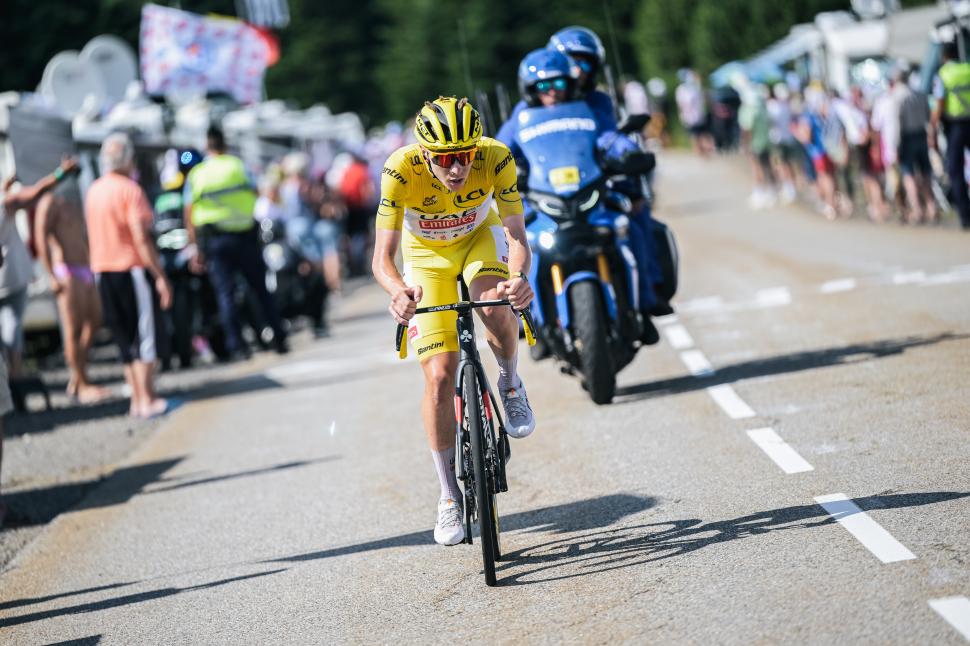 Tadej Pogačar wins stage 15 of the 2024 Tour de France (ASO/Charly Lopez)
Tadej Pogačar wins stage 15 of the 2024 Tour de France (ASO/Charly Lopez)18 July 2024, 08:07
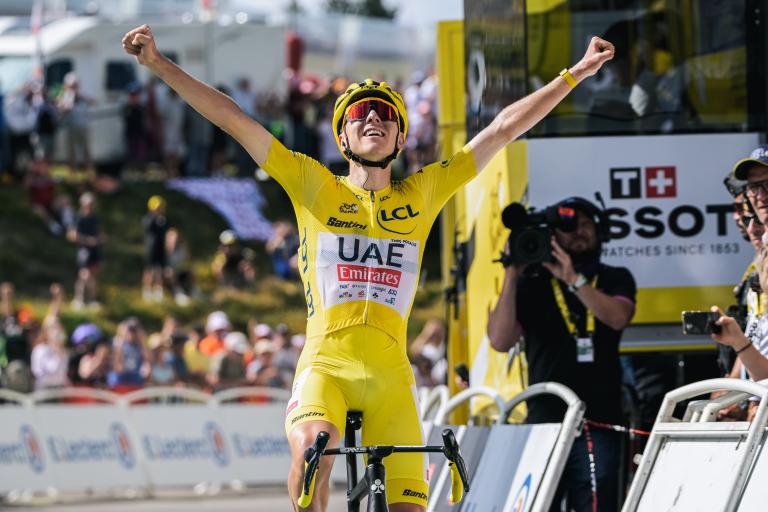
“It’s not like we’re breathing exhaust pipes every day”: Tadej Pogačar confirms carbon monoxide rebreather test for altitude training, but eyebrows raised over WADA's violation of blood manipulation rules
While the 2024 Tour de France has been the stage for Tadej Pogačar to showcase his abilities and continue proving that he’s in a league of his own right now, the dominant performances haven’t come without the ever-so-sharp scrutiny of fans and observers. And some might even say that the scrutiny is, to a degree justified.
Take a look at the man in yellow jersey’s Bastille Day superhuman performance on the final climb of Plateau de Beille. Just after a day of delivering a warning shot to his chief rival Jonas Vingegaard on Pla d’Adet, he made sure that this was the one-two sucker punch Visma-Lease a Bike wouldn’t see coming.
On Sunday, Pogačar smashed the 28-year old record on Plateau de Beille held by Marco Pantani by over three minutes, the UAE Team Emirates rider climbed the 15.8km ascent in a time of 39:41, with commentators and analysts putting his performance up there as one of the best climbing displays of all-time.
But soon enough, the French newspaper L’Equipe ran the headline: “A domination that raises questions”. A headline that followed last week’s revelation from Escape Collective that UAE Team Emirates, Visma-Lease a Bike and Israel Premier Tech have all used the carbon monoxide equipment.
That acceleration by Tadej Pogacar! 🤯 #TDF2024 pic.twitter.com/7mEZkVLkAq
— NBC Sports Cycling (@NBCSCycling) July 17, 2024
Though the practice is not banned by World Anti-Doping Agency (WADA), although some people have mentioned that it appears to conflict with the agency’s rules around artificial manipulation of the blood. The teams, meanwhile, stressed that they had used it purely for testing purposes to “optimise” their altitude training, with Pogačar now confirming it after yesterday’s stage.
The two-time Tour winner said: “It's a test in altitude camp to see how you respond to altitude. You need to do this test, it's like a two- or three-minute-long test. You breathe into a balloon for one minute and then you see the haemoglobin mass, and then you need to repeat it two weeks after.
“But I did just the first part of the test. I never did the second part because the girl who was supposed to come after two weeks didn't come. It's not like we're breathing exhaust pipes every day in the cars. It's just a pretty simple test to see how you respond to altitude training.”
Pogačar had previously brushed off the question when asked about it by reporters. “When I heard this, I was thinking about the car exhaust, I don’t know. I don’t know about that much, so I have no comment. I don’t know what it is. I was always thinking about what goes out from the exhaust of a car,” he said on Tuesday after stage 16, adding with his sly chuckle: “Maybe I’m just uneducated.”
On Monday, Jonas Vingegaard confirmed carbon monoxide rebreathers use in his team in an interview with the Danish newspaper Politiken, saying, “There is nothing suspicious about it.”
Exhaust fumes or not, it will be interesting to see how this situation develops and what WADA and the UCI’s is stance on it.
18 July 2024, 16:26
What is carbon monoxide rebreathing and why is the entire Tour de France talking about it? Tadej Pogačar and Jonas Vingegaard insist it's "nothing suspicious" and "just a simple test", but others are less convinced
Some more handy reading for you, very much on topic with the day's blog...
18 July 2024, 16:12
How do Tour de France riders fuel their race? Top tricks the world's best cyclists use to battle through thousands of brutal kilometres
Sports nutrition has come on along way since the early days of the Tour de France, with teams employing experts to closely monitor their rider's eating and drinking before, during and after their efforts. Here's a detailed look at how they do it
18 July 2024, 15:53
"I played a bit dirty!": Another day for the breakaway at Tour de France as Lotto-Dstny’s Victor Campenaerts wins stage 18
A rare day at the Tour de France as not only did the breakaway enjoy a second consecutive day in keeping the peloton at bay (although enjoyed would be an interesting way to put the pain and suffering they endure), but also because also marking a rare day with no GC attacks on a non-bunch sprint day.
Victor Campenaerts from Lotto-Dstny was the big winner of the day, the 32-year-old Belgian rider outsprinting his breakaway mates Mattéo Vercher and Michael Kwiatkowski and adding a Tour de France stage win to his palmares, alongside the 2021 Giro stage win.
The trio, who had been on the road all on their own for a while reached the final kilometre with a comfortable gap of 26 seconds ahead of the chasing pack, when TotalEnergies’ Vercher decided to launch a very early sprint. That attempt would soon fizzle out as Ineos Grenadiers’ Kwiatkowski did well to reel him in.
From there on, it was a game of cat and mouse as Campenaerts kept his cars very close to his chest, then suddenly launching from behind Kwiatkowski and Vercher in the very final few seconds, leaving them no time to react.
Mice, meet Cat. 🇧🇪@VCampenaerts takes the win after a tough battle of cat and mouse between the trio. Relive the final KM here ⤵️
🇧🇪@VCampenaerts remporte l'étape après une rude bataille du chat et de la souris entre le trio. Revivez la finale KM ici ⤵️#TDF2024 pic.twitter.com/8n99Xo1AFA
— Tour de France™ (@LeTour) July 18, 2024
Campenaerts, welling up with tears, said after the finish: “Winning a stage in Tour de France is everybody’s dream. I have been dreaming of this moment for a very long time. I only had a verbal agreement with the team to extend my contract, went to altitude training camp… It wasn’t easy, I was having a very difficult time.
“My girlfriend supported me through it all, I became a dad and then I started to see the beautiful blue skies. I started feeling good on the bike, and now I believe there’s a future for me as a cyclist,” Campenaerts said, welling up with tears of emotion after the finish.
He added: “I think I played it very smart. My team gave me the confidence, they said I have very good legs. We targeted this stage since December, I looked at stage 18 and said this is the stage I want to win.”
“I even played a dirty, acting like I was hurting, following other people’s wheels, but it worked out in the end… We are going to celebrate tonight!”
The top three of the general classification finished 13:40 behind the breakaway, with no changes to the GC top 10.
18 July 2024, 14:35
Crisps, haribo and now M&Ms, it’s a snacky Tour de France!
You can tell it's relaxed in the peloton 😅
Jasper Stuyven sharing M&Ms around 🇧🇪🍬🍫#TDF2024 pic.twitter.com/UFJoepsdnO
— ITV Cycling (@itvcycling) July 18, 2024
18 July 2024, 09:51
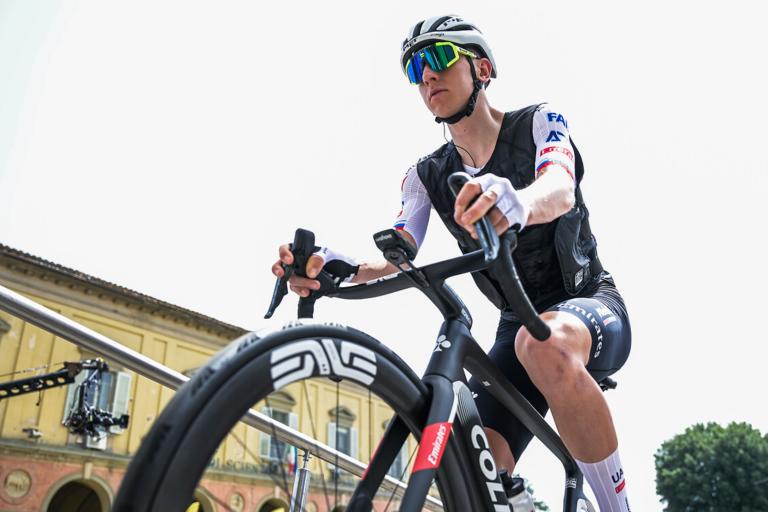
“He is right about some of it, but most of it is wrong”: Tadej Pogačar responds to rumours concerning ‘Mou’, the mysterious figure that’s taken cycling world by storm by claiming to have “insider info” about Pogačar’s training regime
Here’s one for your afternoon lunchtime conspiracy theory read.
If you’ve been spending any time buried in the niche cycling pigeonhole of social media, you’ve probably heard more about one person’s name mentioned more than anyone else in the last few days. No it’s not Tadej Pogačar, no it’s Jonas Vingegaard, no it’s not Elisa Longo Borghini. It’s the anonymous personality who goes by the name of Mou.
This figure came to the prominence when they started posting in detail about UAE Team Emirates’, and specifically Tadej Pogačar’s training camp on a Cyclingnews forum. They even ended up receiving a ban on the forum after some questionable language and claiming that they have “insider knowledge” of Pogačar’s new training methods and regime under new coach Javier Sola.
Who is this mythical prophet »mou« who made the cycling world go crazy today and leaks information about Tadej Pogačar?
A THREAD
1/N pic.twitter.com/xhAltog0rz
— Tratnikmousismo (@Tratnikstan) July 16, 2024
Mou even made a brand new account on Twitter, where they’ve continued to post info about Pogačar and the rest of the UAE Team Emirates, and even some other riders. Recently, he even shared Pogačar’s power profile data, leaving fans in disbelief and some questioning if there was even a mole within the team.
After yesterday’s stage, Danish website Ekstra Bladet asked if Pogačar could shed any light on Mou’s identity. The Slovenian rider replied smilingly: “Maybe I should ask to you guys if you know who this is because I have no idea who this guy is. But yeah, I’ve heard in the last two days he's getting a lot of attention. I think he is right about some of it, but most of it is wrong.
“I don't know who that guy is and what his purpose is. He's just trying to be important on Twitter and on various forums. I don't follow it, but I've heard a lot about it, and people ask. Maybe we can all figure it out together.
“It is perhaps more your task than mine to find out who he is,” he added, referring to the journalists at the press conference.
— mou (@mou55981652) July 16, 2024
Everyone get your tinfoil hats on, let’s figure out who is Mou together!
18 July 2024, 14:03
Some cool TdF analysis! Breaking down the different dynamics you see with a breakaway of nearly 40 riders.
Breaking down the different dynamics you see with a breakaway of nearly 40 riders.#TDF2024 @brentbookwalter @PaulWBurmeister pic.twitter.com/cmwaiZXDMb
— NBC Sports Cycling (@NBCSCycling) July 18, 2024
18 July 2024, 12:14
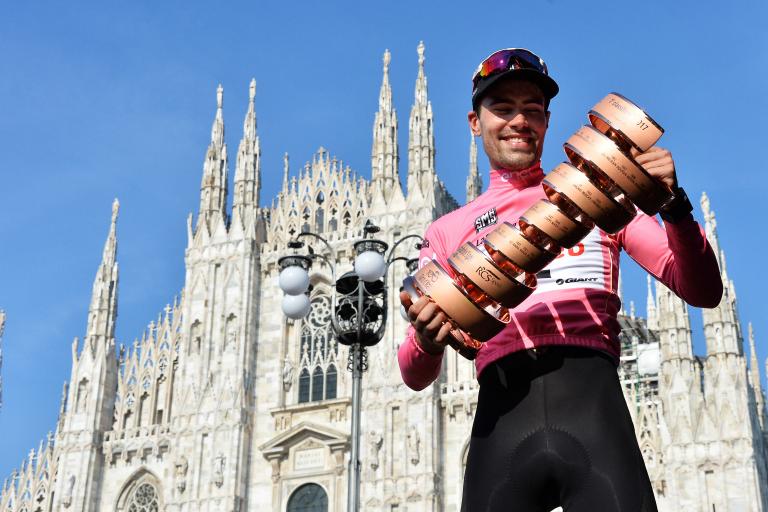
"He does it just to annoy Vingegaard. It has something to do with arrogance": Former pro cyclist Tom Dumoulin lashes out some harsh words at Tadej Pogačar
I know, the blog's probably showing a bit too much love to Pogačar today, but looks like there's someone who doesn't share the same feelings: 2017 Giro d'Italia winner and ex Dutch pro Tom Dumoulin.
hTe former Team DSM–Firmenich PostNL (then known as Team Sunweb, and erm, Project 1t4i) rider had some thoughts to share about yesterday's last-minute antics from the Slovenian who holds the yellow jersey with a three-minute advantage, but decided to make the already-chaotic race even more so with an explosive atack that eventually ended up going nowhere.
Speaking to Dutch news media outlet NOS, Dumoulin said: "This is a pure bluff, it's a mere show of strength. Pogačar is three minutes ahead, he doesn't need to do this. He does it just to annoy Vingegaard. It has something to do with arrogance.
"Pogačar can't stand the fact that he has been beaten for two years in a row. Now he has finally returned to being the boss and has the legs to hurt Vingegaard again. His thought is: now it's all coming back to you."
However, as many people have noted, yesterday's attack probably had less to do with arrogance, and more to do with Pogačar simply being a tenacious yet attacking-minded rider who can conjure the most effortless-looking bursts of acceleration out of nowhere — and all because he admittedly loves racing.
In the past, there have been plenty of instances where Pogačar has attacked without any specific aim or goal. Perhaps the most obvious one that comes to mind is last year's attack on the Champs-Elysees, despite being 7 minutes behind Vingegaard and knowing full-well that it's a stage for the sprinters and he would eventually be caught.
As a Twitter account said: "Relax Tom, it's just Pogi being Pogi..."
18 July 2024, 12:11
Ribble aims to "redefine road" with new Allroad range, with up to 38mm tyre clearance, "world-class" aerodynamics and endurance geometry
Ribble has completely overhauled its lineup with the introduction of the Allroad range, featuring three new road bikes: the Allroad SL R, Allroad SL and Allroad SL R e. The top-tier SL R offers space for tyres up to 38mm wide, internal storage and "world-class aerodynamic performance" paired with endurance-specific geometry, according to Ribble. Prices for the Allroad bikes start at £1,699 and go all the way up to £8,499, and we've already got one of each model for review. Read on for all the juicy tech info and our senior reviewer's first impressions...
18 July 2024, 11:10
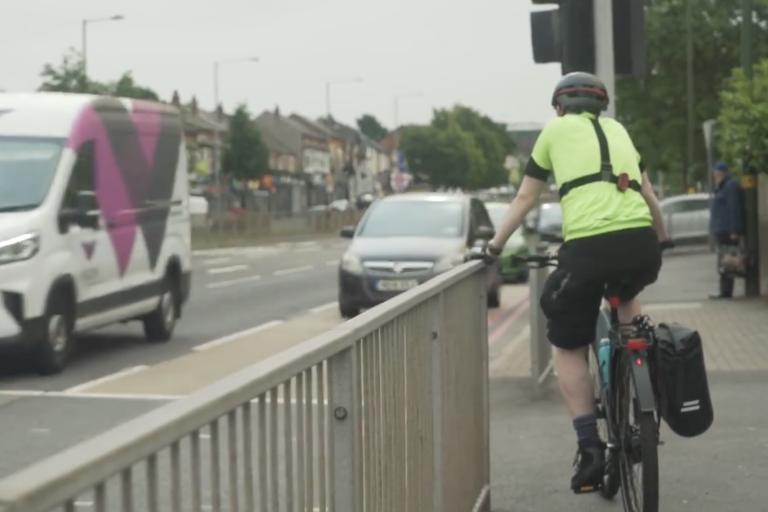
“When there are still people dying daily, it represents a massive failure”: Cyclists organise solidarity ride in Birmingham after three cyclists killed last month
Cyclists in Birmingham have fighting to keep their peers alive for quite some time, and last month, there was another unfortunate development in the crusade, with three riders dying in collisions.
It’s not the first time this has happened in the city. Last year, things came to a head with a spate of protests and actions organised after seven hit-and-runs, with four cyclists, including a 12-year-old boy, “killed by motorists” in just over three weeks.
And it looks like things have taken a turn for the worse once again, with history repeating itself as three cyclists losing their lives once again in the last month. To mark this tragic event, people across Birmingham came together this morning to “cycle in solidarity” with those who have lost their lives and their grieving families and friends.
Three cyclists have been killed on Birmingham’s streets in the last month. Tomorrow morning at 8am people across Birmingham will come together to “cycle in solidarity” with those who have lost their lives and their grieving families and friends.@for_harbquin @for_birmingham pic.twitter.com/NgtapfbFY5
— Sarah Chaundler (@ChaundlerSarah) July 17, 2024
Mat MacDonald from Better Streets for Birmingham said: “We know that it’s possible to structure roads and organise our laws and educate our drivers in such a way that people don’t have to die under the wheels of a vehicle. And so when there are still people dying in this way daily, it represents a massive failure on the part of the authorities who can make that happen.
“So we need to see more investment and protection for people outside the vehicles, lower speed limits across the city so that where vehicles and people and vulnerable road users such as cyclists are mixing together, cars are travelling slow enough that if there’s a collision, they are not going to kill, they’re not going to seriously injure.
“And we need to see just more availability for people to travel without needing to use a car in safety around the city.”
Last year in June, hundreds of people came together to protest the increasingly dangerous state of roads in Birmingham at the Kings Heath junction, the spot where 13-year-old Hope Fenell was riding her bike when she was struck by an HGV driver in 2011.
The protest was marked by emotionally charged people chanting “Shame on you” at drivers overtaking dangerously, speeding, changing lanes — all behaviour that lead to deaths on streets, Paul Manzotti from Better Streets for Birmingham told road.cc.
And just last week, a reporter at the Birmingham Mail decided to buck the depressing trend of constant negative press coverage around cyclists by criticising the general indifference that permeates British attitudes towards active travel and which views cycling fatalities as a “normal part of urban life”.
He asked “Where is the outrage?”, however readers only proceeded to respond to his call for improved cycling infrastructure by claiming that cyclists “think they own the road then suffer the consequences”, and demanding the introduction of cycling-specific licences, insurance, and mandatory helmets and hi-vis clothing.
18 July 2024, 10:55
Yet another cyclist ordered to pay £500 for cycling through town centre, as council insists those who "have not followed the rules" will be "rightly punished"
Another cyclist has found themselves on the receiving end of a hefty bill for riding through the town centre, a council continuing to enforce a controversial cycling ban and warning that cyclists will be "rightly punished" and face "repercussions" if they "have not followed the rules".
The long-running saga in Grimsby concerns Public Spaces Protection Orders (PSPO) that North East Lincolnshire Council introduced in 2019, and that have seen more than 1,000 fixed-penalty notices issued since then, the bulk of which have been for cycling on Victoria Street South and walking dogs along the main beach.
18 July 2024, 10:29
Yeah but cyclists riding on the pavement is the biggest danger to pedestrians right?
Cyclists riding on the pavement is the biggest danger to pedestrians pic.twitter.com/WKOb1lHqsv
— Yeah But Cyclists (@but_cyclists) July 16, 2024
18 July 2024, 09:25
After blowing into balloons for carbon monoxide tests comes under scrutiny, what's next? Helium balloons?!
As carbon monoxide rebreathers come under scrutiny for maybe violating WADA's code regulations for blood manipulation, cycling has already found the next big doping farce to muddy itself with. Presenting to you, the "balloon doping" scandal, where riders tie helium balloons to their jersey's back pockets and climb the world's most difficult climbs. What a sight that would be!
2026: Cycling collapses after "balloon doping" scandal https://t.co/g4Smj6JzxE
— Prof. Ian Walker (@ianwalker) July 18, 2024
Adwitiya joined road.cc in 2023 as a news writer after completing his masters in journalism from Cardiff University. His dissertation focused on active travel, which soon threw him into the deep end of covering everything related to the two-wheeled tool, and now cycling is as big a part of his life as guitars and football. He has previously covered local and national politics for Voice Cymru, and also likes to write about science, tech and the environment, if he can find the time. Living right next to the Taff trail in the Welsh capital, you can find him trying to tackle the brutal climbs in the valleys.
Latest Comments
- Rendel Harris 3 sec ago
Genuinely puzzled as to how you've extrapolated that from what I said. Care to explain?
- Rendel Harris 5 min 22 sec ago
If we can't have a debate over whether TNT shouldn't be allowed to take over cycling coverage and charge five times more for it, can we have a...
- chrisonabike 1 hour 43 min ago
The issue is we just end up with wider vehicles parked on the road because they won't fit the garage *, and it being more likely that drivers will...
- Pub bike 2 hours 10 min ago
He is up against the global trading system, which has obviously been in the news a lot lately. Framebuilders in other countries can undercut him,...
- David9694 3 hours 43 min ago
Stouport residents bemoan huge traffic queues through town...
- rookybiker 14 hours 37 min ago
The trailer seems to connect to both ends of the rear axle. Can it do tight corners without dragging the tyre sideways?
- froze 14 hours 40 min ago
Motorists have always been unkind to cyclists, but distracted driving is adding to the problem....
- Destroyer666 15 hours 34 min ago
Have you owned Bont shoes? In my experience even the widest Lake shoes have had a bizarre form of narrowing way too much in the toe area. But the...
- froze 16 hours 1 min ago
Not sure if this is possible, but this news letter goes out all over the world, and some places like Decathlon does not send stuff to America, in...




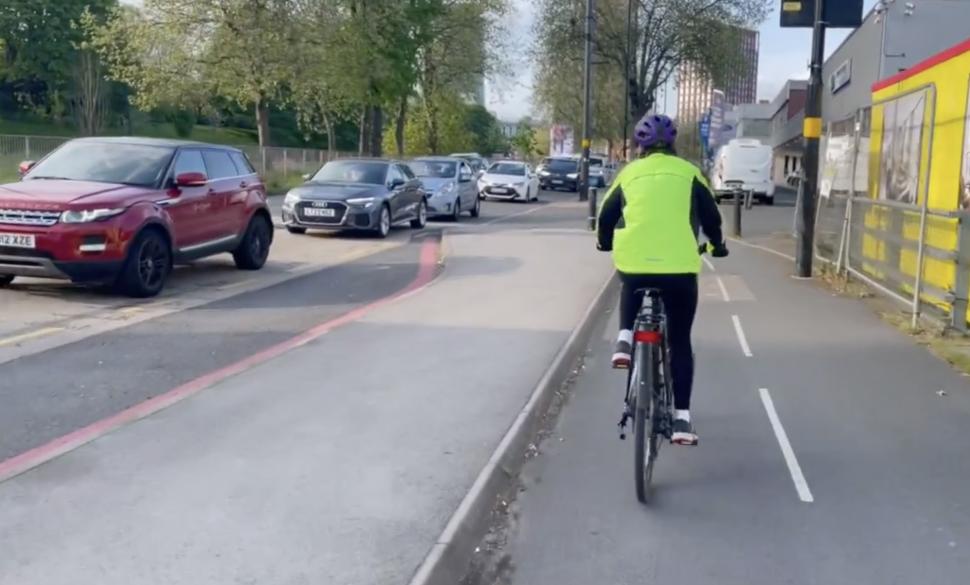
Add new comment
29 comments
A full vision of a rather energetic Didi the Devil in the final few Kms of today's stage, even featured in the highlights show.
Surely the officials should have intervened here? It's one thing doing a bit of drafting after a mechanical or crash, but in the run up to the sprint it's totally out of order.
4 years for Just stop Oil on peaceful protest
Kill 4 people in an HGV and it's only 3
https://www.essex.police.uk/news/essex/news/news/2024/april/driver-jaile...
The anti-clockwise section of the M25 was closed for 11-and-a-half hours.
I like how the BBC have stated how many hours 'driver delays' the protest caused. I wonder if they can do the same for the hours of life lost for deaths on the road, for example 1 person's life cut short by 30 years, thats over 260,000 hours lost.
Or how many hours of 'driver delays' drivers cause. Just thinking about the time I spent three hours on the Severn Bridge last time I tried to drive to Chelt. Or the time it took me nearly 12 hours to get fron Newport to Swansea the year berfore.
The delays these protests cause is irrelevant compared to the delays caused by "I only need to go half a mile down the road, I'll grab my car keys".
This afternoon the local paper reported 4 miles of tailbacks and a 60-minute delay after a car fire closed a lane on the M54. There had been a less disruptive car fire on the same road this morning.
Also this morning the A41-to-A49 roundabout near Whitchurch was closed from 5am after a lorry trailer became detached while a little later a 3-car collision on the A41 closed this notorious road at Hinstock, with 2 occupants suffering "potentially serious injuries".
Shrewsbury town centre has more than its share of bottleneck junctions. Drivers must waste so much time trying to use the town centre streets as a shortcut. I was told that the High Street was at a standstill at lunchtime. I happened to be in the town centre just before 5pm (cycling, of course) and found a long stationary queue then as well. Apparently there were still queues near Welsh Bridge at 6.30pm. Madness!
All these drivers want to blame someone or something else for the queue but the plain fact of the matter is that every single vehicle is contributing to the problem.
That's it.
Yes, everyone has a part (even if it's just occasionally holding the powers to be to account in some tangential way). And it not only takes "leadership" - it is "imposing on people" * and a lack of political caution. But to quote Churchill (who wasn't banging on about transport to be fair) "It is not enough that we do our best; sometimes we must do what is required."
* On this notion that it's unheard of for authorities to act without a majority being in favour (or even a minority shouting very loud)... while very frequently governance is reactive it's never stopped 'em leading from the front for the lobbies with cash and connections!
Several transfers of staff from Lancs to Essex
colchester cycling posted:
" Extra Eyes reports and outcomes from @EPRoadsPolicing
for June 2024 https://saferessexroads.org/extra-eyes/
We are concerned to see such a low percentage of reports by cyclists resulting in a notice of intended prosecution. We will raise with @EPRoadsPolicing. "
NFA on this one yesterday
How close does a driver need to get ?
Oh no! Don't tell me the market is overheating, with high transfer fees for the prized most highly anti-cyclist and pro-motorist officers?
At least they didn't "lose" it like they did to this report I sent in.
The mad thing is that it shouldn't matter if they lose it. I wouldn't expect to murder someone, steal from or assault someone and then turn around and say "well, its been a few months since I 'apparently' killed them so you can't do me for it".
Somehow thats how it works in driving related crime.
How close does a driver need to get ?
Much closer, if there are indeed 'ringers' working there on transfer from Lancashire- don't forget these are (in the words of Indiana Jones and the Ark of the Covenant) Top Men, trained since recruitment under the stringent '2 O-Levels or Less' criterion to ignore even hitting a cyclist while driving down the wrong side of the road and to claim it was 'only a momentary loss of concentration'. They ignored this Sainsbury's 44 tonner driver, so they would have no trouble binning any close pass report from some whingeing Essex cyclist who hasn't even been KSI'd, or phone offence, or unbroken white line offence, or red light offence, or No MOT offence etc. etc
On the plus side they're still publishing numbers, I've not seen anything out of Suffolk, not even a local press round up article, for going on two years now
Here is a still from a report in Gloucestershire.
NFA but the PC did see fit to explain the decision. A return to feedback after a year of hearing nothing from any of my reports during 2023.
Here is my reply
And here is another email I got from a different PC but for the other close pass a few seconds earlier
Yes, that's the way they do it. As far as most PCs involved in OpSnap are concerned, it is impossible to prove to his satisfaction that a pass is too close. They begin with that conclusion, cut and paste in the standard letter, alter a few words- job done! When the driver actually hits you, you're either KSI'd in which case: job done again, because the only witness is the driver who did it- who is unharmed and our thoughts and prayers go out to him for having to live with it- or you're OK in which case there's still no problem and you must have done something wrong or it wouldn't have happened. The quality of evidence doesn't matter to them, they'll still think of something really stupid to say about it. If they really can't think of a way to dispute the closeness, or blame the cyclist, then they resort to not responding for a couple of weeks or years and blaming pressure of work
The balloon doping sounds like it's stolen from the plot of the 1997 film, Shooting Fish - https://en.wikipedia.org/wiki/Shooting_Fish
That never made much sense to me because surely they were just moving the helium from one place to another, which would not affect their weight at all?
A balloon would be a bad idea, the aerodynamic drag even at climbing speeds would offset any reduction in weight. According to tinternet 1 litre of helium at atmospheric pressure will lift about 1g, so you need a large volume that would be aerodynamic and not noticeable to the officials/ your rivals.
The CO breathing described is NOT doping. It's a standard method in (sports) physiology to determine the total haemoglobin mass in a human. You take a sample of someone's blood and you measure the percent of carboxyhaemoglobin. You then take a volume of oxygen and add a fixed, known amount of CO to it. You then get the subject to rebreathe this volume. It has been established that with X (I forgot how much) rebreathing, effectively all the CO will have been absorbed by the subject and be bound to their blood. (CO binds to haemoglobin preferentially above O2 and CO2). You take another sample of blood and determine the fraction of carboxyhaemoglobin.
You know now:
1. The fraction of carboxyhaemoglobin before CO rebreathing
2. The fraction of carboxyhaemoglobin after CO rebreathing
3. Exactly how much CO went into the subject
Using this you and knowing the increase in the fraction, you can work out the total amount of haemoglobin in the blood.
This is - in the immediate term - actually performance _decreasing_. Because the CO binds strongly to that haemoglobin, and you've basically lost that haemoglobin for oxygen transport for X days (2 or 3? I forget).
However, if done repeatedly for a period of time [not sure how long - probably has to be at least weeks] and then stopped, it may be performance enhancing. Because your body perceives it has /less/ haemoglobin, and so it makes more. Your body is trying to bring the fraction of /available/ haemoglobin to a normal level (similar to altitude training). Then, when you stop the CO rebreathing, after X days, the previously CO-bound haemoglobin manages to unbind and also becomes available, and you have an increase in available haemoglobin - for a while.
I'm not a sports physio Ph.D. myself, but I've been put through the CO/haemoglobin mass method as part of a sports science study, and the post-docs were explaining it to me.
CO is highly toxic, so I would assume that the levels introduced into the body during one of these tests is minute, you wouldn't do it every day and as a result the body would not have the drive to adapt (at least not to a significant level compared to the effect of sleeping/ training at altitude).
My understanding is that the time it takes to get rid of it is depedent on the amount of oxygen you are breathing in, so getting rid of the CO at altitude would take longer than at sea level.
CO is highly toxic
Yes and no! The dimwit smokers will have levels of carbonmonoxyHb up to 10%
This is a complete non story. The test involves taking a short breath of CO. It has no effect on red cell count and due to the toxicity of CO is restricted to a single breath.
Someone has to win. All this automatic questioning of the winner without any evidence other than they are winning just dampens the enjoyment.
Remember that Pog was 7' 23" down on the stage winner yesterday, so not exactly blistering.
It looks to me that Jonas is starting to show the far less than perfect preparation leading into this year's TdF now we are into the 3rd week, and is beginning to fade, but we will see. Could be interesting as Remco looks like he sees a chance to get 2nd.
The circumstances aren't merely that Pog is winning, but that up certain climbs he has demolished the times of riders of doping eras past.
The situation is that the sport has completely changed in basically every single way since those days. Training, diet, nutrition on and off the bike, equipment, tactics. Something as simple as fuelling on the bike makes a monstrous difference. I would love to see what would happen if we took a modern athlete and doped them up to the levels those guys were.
Pantani's bike was probably 300g, perhaps closer to 0.5 kg, lighter than Pog's.
Interesting comparison here:
https://road.cc/content/feature/pantanis-1998-bianchi-vs-pogacars-2024-c...
The questioning is entirely legitimate given the sport's long history of doping. If nothing else then hopefully it reminds riders to stay honest and clean.
Hardly relevant, even Armstrong would let a breakaway go when it suited him. I'm a huge fan of Pogacar and don't believe he is doping but the fact that he finished down on the breakaway on what was effectively an armistice day for the GC contenders doesn't prove anything.